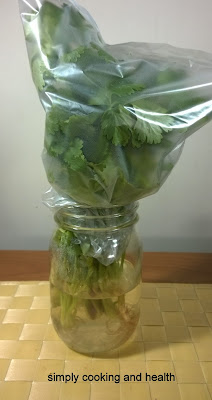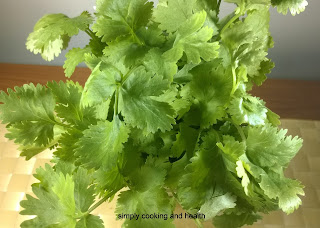 |
| Coriander leaves |
In coriander, fresh leaves and the dried seeds are the parts most traditionally used in cooking.
Fresh leaves are known as cilantro in North
America . It is also known as Chinese parsley in South
Asia .
The leaves have a totally different taste compared to the
seeds. Leaves have a strong aroma and an unpleasant soapy taste. You either
love it or hate it. Both leaves and the seeds are commonly used in Indian
cuisine. Leaves are used in such as chutneys and salads in Indian coking. In
Chinese and Thai dishes they are used as a garnish. Coriander leaves is the
main ingredient in many sauces served atop grilled meats and in guacamole. It
may also used in pesto and salsa.
The leaves spoil quickly and loose their aroma when dried or
frozen.
Nutrition information for coriander leaves is found in USDA
data base here.
The word coriander in food preparation refers solely to the
seeds, as a spice, rather than to the plant or the leaves. The seeds can be
dried and stored for a long time without any deterioration in aroma and taste.
Coriander seeds are an essential ingredient in curries and curry powder. Coriander balances the heat of chili in curry powder. Coriander determines the heat of the curry powder. Less coriander and more dry chili gives a hot curry powder. To make mild curry powder you add more coriander. Coriander powder without chili is also used in making mild curry.
Coriander tea made from coriander seed powder is sometimes consumed to fight cold and fever. It is also used for toxic metal cleansing. It may reduce blood sugar levels in diabetes. Whether it has any cholesterol lowering properties is now being studied.
Coriander tea made from coriander seed powder is sometimes consumed to fight cold and fever. It is also used for toxic metal cleansing. It may reduce blood sugar levels in diabetes. Whether it has any cholesterol lowering properties is now being studied.
Nutrition information for coriander seeds is here in the
USDA database.
Storing coriander leaves
Wash and dry the leaves. Do not remove the root. Spread the
leaves in a long paper towel. Roll the paper towel into a cylindrical form. Put
it in a plastic bag and put a knot on the top of the bag to make it air tight.
Store the bag in the fridge. To freshen the leaves place the root side of the
cilantro in a glass half filled with plain water. Cover the leafy part with a
plastic bag. Leave the glass on the counter top. It will last for a couple of
days on the counter top. Change the water every two days.
 |
| Covered coriander leaves |
 |
| After removing the plastic bag |
Coriander leaves lose their potency if dried. But microwave drying will preserve some of the flavours and color, compared to other forms of drying.
You may also try blanching and freezing the coriander leaves. It will not taste like fresh leaves but it is
better than dried leaves.
 |
| Fresh coriander leaves |

No comments:
Post a Comment